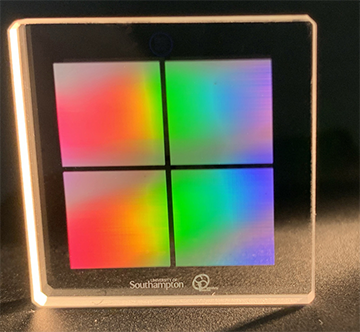
Researchers in the UK have shown how to speed up the writing of data to a glass plate by modifying the energy of a series of femtosecond laser pulses. [Image: Yuhao Lei and Peter G. Kazansky, University of Southampton]
The ever-greater amount of data accumulating in the digital age calls for new storage techniques that are long-lived, energy-efficient and practical. Researchers in the UK think they might have found the answer, having used the polarization of femtosecond laser pulses to orient nanosized structures in glass plates (Optica, doi: 10.1364/OPTICA.433765). They reckon that their approach could ultimately allow 500 terabytes to be stored on a single compact-disc sized device.
Increasing the energy efficiency
Data centers today use a variety of technologies to try and meet increasing storage demands, but each has its limitations. Hard disks consume lots of energy and usually only last for a few years, while magnetic tapes are too slow for everyday use. Conventional optical discs such as CDs and DVDs are also quite slow as well as having limited lifetimes.
In the latest work, Peter Kazansky and colleagues at the University of Southampton, UK, propose a device with a potentially unlimited lifetime that uses pulses from a femtosecond laser source to store data within a piece of silica glass across five dimensions—the three spatial dimensions as well as two parameters that characterize the silica's birefringence. Writing to the device involves modulating the laser's polarization and intensity so as to encode data via the slow-axis orientation and retardance (the optical path difference between two orthogonal polarizations) of nanometer-sized structures within the silica.
The Southampton group has already demonstrated that this technique can work in principle, but has been hampered by the need for multiple laser shots to create a single nanostructure. Writing data quickly requires that the laser operate at a high repetition rate, but beyond a certain rate the process generates too much heat and the data cannot be accurately encoded.
Kazansky and colleagues have now shown how this problem can be minimized by increasing the energy efficiency of the writing process. They did so by splitting that process into two stages. First, they use one or more "seeding" laser pulses with relatively high energies to create a tiny explosion that leaves a uniform circular void about 130 nm across the silica. They then employ multiple "writing" pulses at a lower energy to elongate that void by about a factor of five at right angles to the light's polarization axis—and so encode the data.
They were able to lower the energy of the writing pulses by exploiting the phenomenon of near-field enhancement. The electric field generated by these pulses is amplified at the edge of the void, created by the seeding pulses, in the plane perpendicular to the pulses' polarization. That enhanced field ionizes the silica and thereby writes the data point, or "voxel".
Writing at light speed
To demonstrate how the technique could be used to store data in practice, the researchers employed a laser with a wavelength of 515 nm and a repetition rate of 10 MHz that they scanned across a 120mm-diameter silica plate using an acousto-optic deflector. Each voxel required one seeding pulse and either four or seven writing pulses, depending on which of two retardance levels was needed to encode that particular voxel.
With eight possible polarizations—corresponding to eight specific slow-axis orientations—for each of the two retardance levels, each voxel could be placed in any of 16 possible configurations and therefore accommodate four binary bits. By scanning at a rate of 1 million voxels per second, they were able to write 5 gigabytes of data to 50 layers spanning the disc's 2.4-mm thickness in five hours. They then found that they could read the data back with an accuracy of “almost 100%”.
Future improvements
Kazansky and co-workers say that writing speeds could be boosted to megabytes per second by upping the repetition rate to 50 MHz. They also think it’s feasible to double the number of bits per voxel by increasing the number of slow-axis orientations and reducing the size of the device so that voxels are spaced just 0.2 micrometers apart and adjacent layers are separated by just 3 micrometers. In that case, they say, a 4-mm thick 127-mm diameter glass plate could store about 500 terabytes of data.
The researchers point out that there remains one significant weakness in their current scheme—reading speeds. Their manually-controlled imaging system limited reading to the glacial pace of just a few bytes per second. But they are confident that this will not prove a showstopper, arguing that by employing automatic polarization imaging and more powerful decoding algorithms they could up the speed to tens of megabytes per second.
